Competitive Strategy Analysis of Nestle and Starbucks Essay
VerifiedAdded on 2020/02/19
|6
|1352
|649
Essay
AI Summary
This essay provides a comprehensive analysis of the competitive strategies employed by Nestle and Starbucks, two prominent international companies. It begins with an overview of Nestle, exploring its global presence, the CAGE framework, and its business model innovation, including the adaptation of a shared value strategy and the razor blade model exemplified by Nespresso. The essay then shifts its focus to Starbucks, examining its evolution from a coffee bean retailer to a global brand. It applies the CAGE framework to Starbucks' international business strategy, highlighting its local adaptations and partnerships. Furthermore, the essay identifies five key innovations in Starbucks' business model, such as sustainable culture and customer experience, and outlines the four steps the company undertook to achieve these innovations. Through a comparative analysis, the essay offers insights into the strategic approaches of both companies, emphasizing their adaptations to different markets and their focus on customer value and revenue generation.
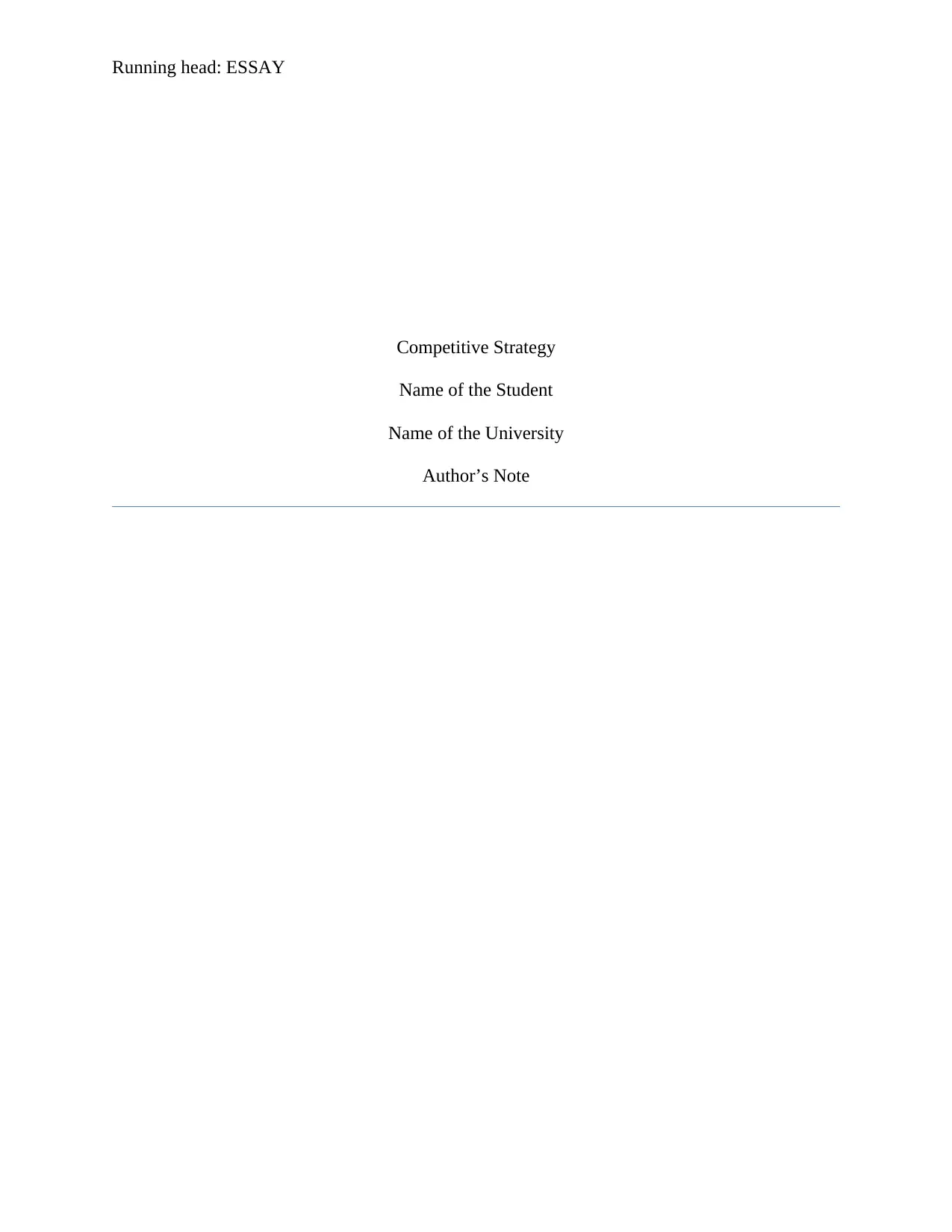
Running head: ESSAY
Competitive Strategy
Name of the Student
Name of the University
Author’s Note
Competitive Strategy
Name of the Student
Name of the University
Author’s Note
Paraphrase This Document
Need a fresh take? Get an instant paraphrase of this document with our AI Paraphraser
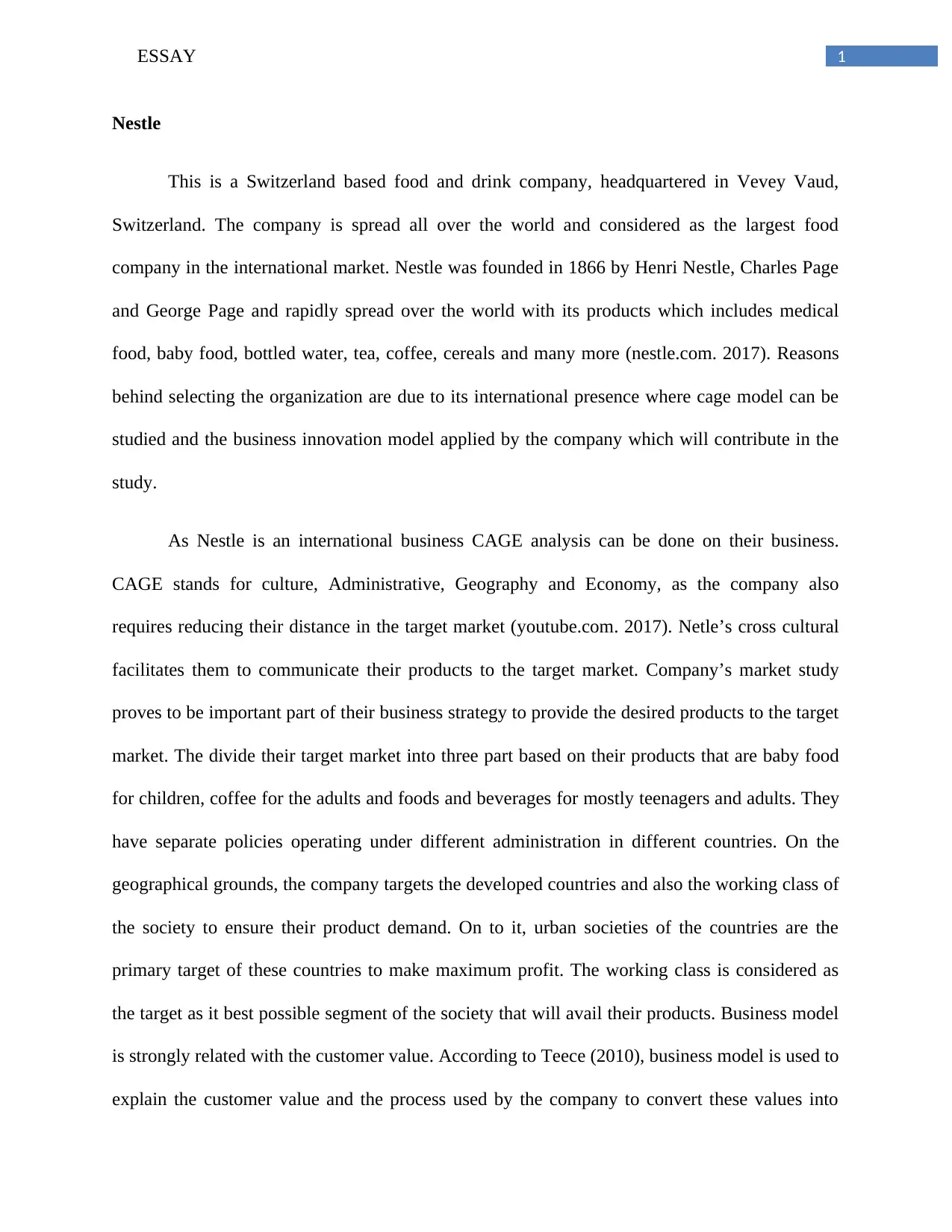
1ESSAY
Nestle
This is a Switzerland based food and drink company, headquartered in Vevey Vaud,
Switzerland. The company is spread all over the world and considered as the largest food
company in the international market. Nestle was founded in 1866 by Henri Nestle, Charles Page
and George Page and rapidly spread over the world with its products which includes medical
food, baby food, bottled water, tea, coffee, cereals and many more (nestle.com. 2017). Reasons
behind selecting the organization are due to its international presence where cage model can be
studied and the business innovation model applied by the company which will contribute in the
study.
As Nestle is an international business CAGE analysis can be done on their business.
CAGE stands for culture, Administrative, Geography and Economy, as the company also
requires reducing their distance in the target market (youtube.com. 2017). Netle’s cross cultural
facilitates them to communicate their products to the target market. Company’s market study
proves to be important part of their business strategy to provide the desired products to the target
market. The divide their target market into three part based on their products that are baby food
for children, coffee for the adults and foods and beverages for mostly teenagers and adults. They
have separate policies operating under different administration in different countries. On the
geographical grounds, the company targets the developed countries and also the working class of
the society to ensure their product demand. On to it, urban societies of the countries are the
primary target of these countries to make maximum profit. The working class is considered as
the target as it best possible segment of the society that will avail their products. Business model
is strongly related with the customer value. According to Teece (2010), business model is used to
explain the customer value and the process used by the company to convert these values into
Nestle
This is a Switzerland based food and drink company, headquartered in Vevey Vaud,
Switzerland. The company is spread all over the world and considered as the largest food
company in the international market. Nestle was founded in 1866 by Henri Nestle, Charles Page
and George Page and rapidly spread over the world with its products which includes medical
food, baby food, bottled water, tea, coffee, cereals and many more (nestle.com. 2017). Reasons
behind selecting the organization are due to its international presence where cage model can be
studied and the business innovation model applied by the company which will contribute in the
study.
As Nestle is an international business CAGE analysis can be done on their business.
CAGE stands for culture, Administrative, Geography and Economy, as the company also
requires reducing their distance in the target market (youtube.com. 2017). Netle’s cross cultural
facilitates them to communicate their products to the target market. Company’s market study
proves to be important part of their business strategy to provide the desired products to the target
market. The divide their target market into three part based on their products that are baby food
for children, coffee for the adults and foods and beverages for mostly teenagers and adults. They
have separate policies operating under different administration in different countries. On the
geographical grounds, the company targets the developed countries and also the working class of
the society to ensure their product demand. On to it, urban societies of the countries are the
primary target of these countries to make maximum profit. The working class is considered as
the target as it best possible segment of the society that will avail their products. Business model
is strongly related with the customer value. According to Teece (2010), business model is used to
explain the customer value and the process used by the company to convert these values into
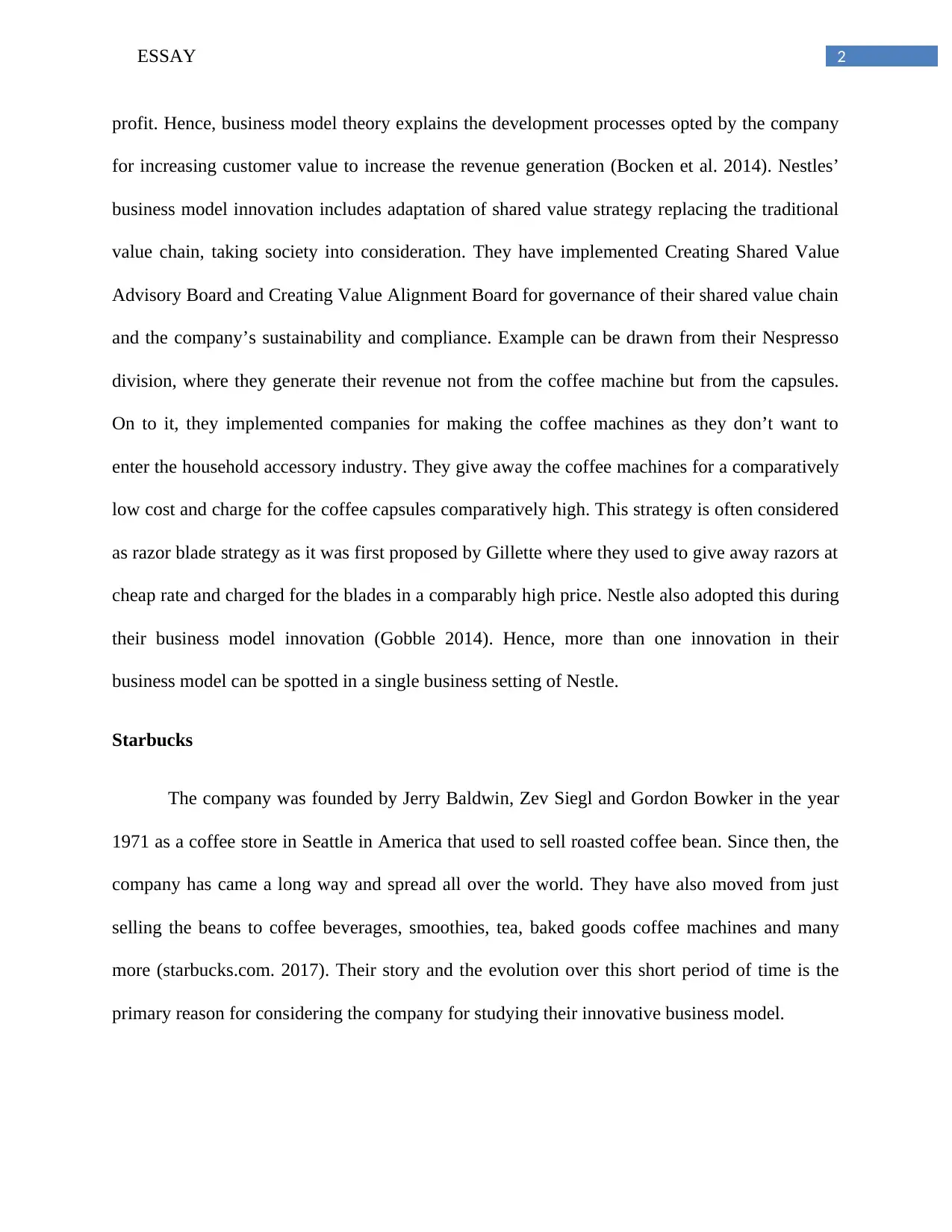
2ESSAY
profit. Hence, business model theory explains the development processes opted by the company
for increasing customer value to increase the revenue generation (Bocken et al. 2014). Nestles’
business model innovation includes adaptation of shared value strategy replacing the traditional
value chain, taking society into consideration. They have implemented Creating Shared Value
Advisory Board and Creating Value Alignment Board for governance of their shared value chain
and the company’s sustainability and compliance. Example can be drawn from their Nespresso
division, where they generate their revenue not from the coffee machine but from the capsules.
On to it, they implemented companies for making the coffee machines as they don’t want to
enter the household accessory industry. They give away the coffee machines for a comparatively
low cost and charge for the coffee capsules comparatively high. This strategy is often considered
as razor blade strategy as it was first proposed by Gillette where they used to give away razors at
cheap rate and charged for the blades in a comparably high price. Nestle also adopted this during
their business model innovation (Gobble 2014). Hence, more than one innovation in their
business model can be spotted in a single business setting of Nestle.
Starbucks
The company was founded by Jerry Baldwin, Zev Siegl and Gordon Bowker in the year
1971 as a coffee store in Seattle in America that used to sell roasted coffee bean. Since then, the
company has came a long way and spread all over the world. They have also moved from just
selling the beans to coffee beverages, smoothies, tea, baked goods coffee machines and many
more (starbucks.com. 2017). Their story and the evolution over this short period of time is the
primary reason for considering the company for studying their innovative business model.
profit. Hence, business model theory explains the development processes opted by the company
for increasing customer value to increase the revenue generation (Bocken et al. 2014). Nestles’
business model innovation includes adaptation of shared value strategy replacing the traditional
value chain, taking society into consideration. They have implemented Creating Shared Value
Advisory Board and Creating Value Alignment Board for governance of their shared value chain
and the company’s sustainability and compliance. Example can be drawn from their Nespresso
division, where they generate their revenue not from the coffee machine but from the capsules.
On to it, they implemented companies for making the coffee machines as they don’t want to
enter the household accessory industry. They give away the coffee machines for a comparatively
low cost and charge for the coffee capsules comparatively high. This strategy is often considered
as razor blade strategy as it was first proposed by Gillette where they used to give away razors at
cheap rate and charged for the blades in a comparably high price. Nestle also adopted this during
their business model innovation (Gobble 2014). Hence, more than one innovation in their
business model can be spotted in a single business setting of Nestle.
Starbucks
The company was founded by Jerry Baldwin, Zev Siegl and Gordon Bowker in the year
1971 as a coffee store in Seattle in America that used to sell roasted coffee bean. Since then, the
company has came a long way and spread all over the world. They have also moved from just
selling the beans to coffee beverages, smoothies, tea, baked goods coffee machines and many
more (starbucks.com. 2017). Their story and the evolution over this short period of time is the
primary reason for considering the company for studying their innovative business model.
⊘ This is a preview!⊘
Do you want full access?
Subscribe today to unlock all pages.

Trusted by 1+ million students worldwide
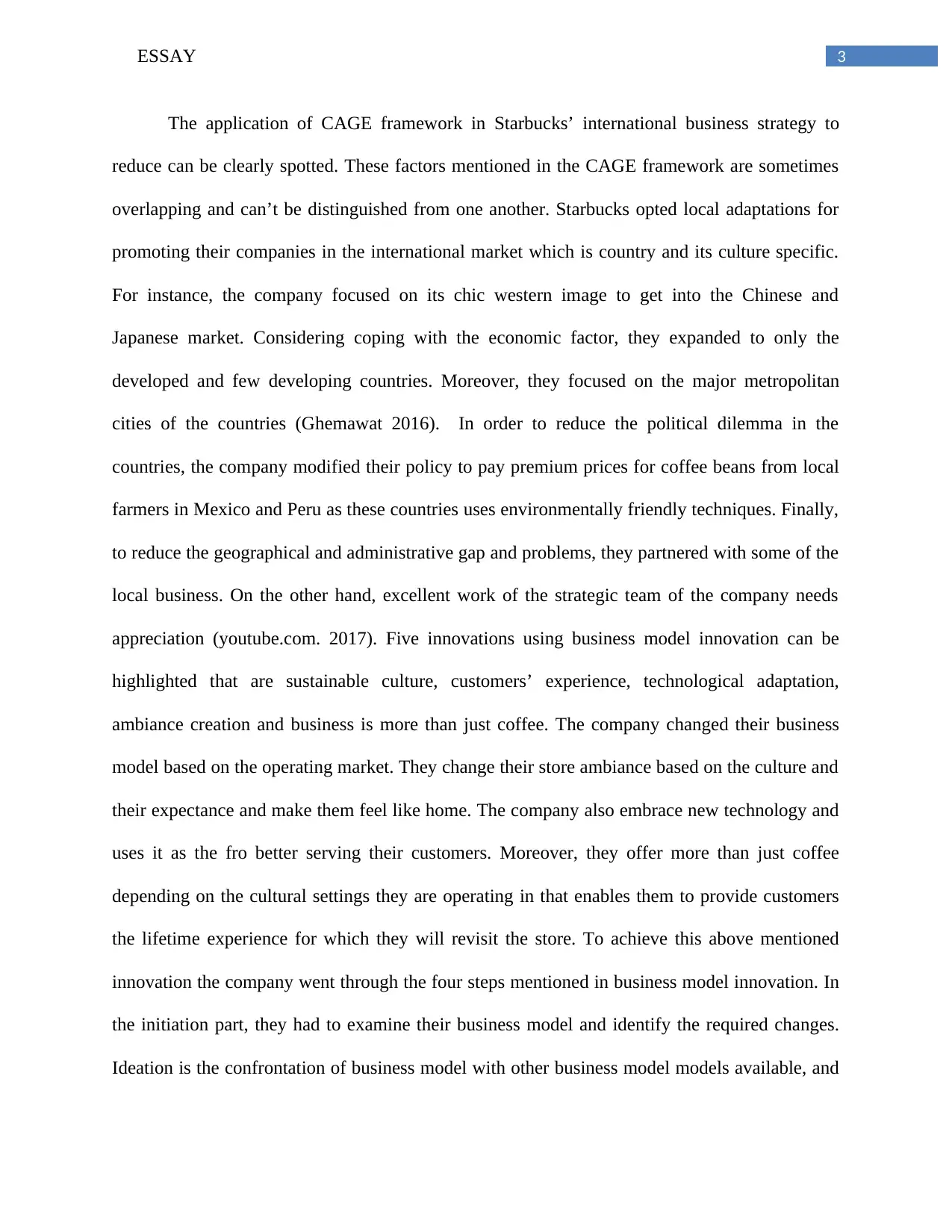
3ESSAY
The application of CAGE framework in Starbucks’ international business strategy to
reduce can be clearly spotted. These factors mentioned in the CAGE framework are sometimes
overlapping and can’t be distinguished from one another. Starbucks opted local adaptations for
promoting their companies in the international market which is country and its culture specific.
For instance, the company focused on its chic western image to get into the Chinese and
Japanese market. Considering coping with the economic factor, they expanded to only the
developed and few developing countries. Moreover, they focused on the major metropolitan
cities of the countries (Ghemawat 2016). In order to reduce the political dilemma in the
countries, the company modified their policy to pay premium prices for coffee beans from local
farmers in Mexico and Peru as these countries uses environmentally friendly techniques. Finally,
to reduce the geographical and administrative gap and problems, they partnered with some of the
local business. On the other hand, excellent work of the strategic team of the company needs
appreciation (youtube.com. 2017). Five innovations using business model innovation can be
highlighted that are sustainable culture, customers’ experience, technological adaptation,
ambiance creation and business is more than just coffee. The company changed their business
model based on the operating market. They change their store ambiance based on the culture and
their expectance and make them feel like home. The company also embrace new technology and
uses it as the fro better serving their customers. Moreover, they offer more than just coffee
depending on the cultural settings they are operating in that enables them to provide customers
the lifetime experience for which they will revisit the store. To achieve this above mentioned
innovation the company went through the four steps mentioned in business model innovation. In
the initiation part, they had to examine their business model and identify the required changes.
Ideation is the confrontation of business model with other business model models available, and
The application of CAGE framework in Starbucks’ international business strategy to
reduce can be clearly spotted. These factors mentioned in the CAGE framework are sometimes
overlapping and can’t be distinguished from one another. Starbucks opted local adaptations for
promoting their companies in the international market which is country and its culture specific.
For instance, the company focused on its chic western image to get into the Chinese and
Japanese market. Considering coping with the economic factor, they expanded to only the
developed and few developing countries. Moreover, they focused on the major metropolitan
cities of the countries (Ghemawat 2016). In order to reduce the political dilemma in the
countries, the company modified their policy to pay premium prices for coffee beans from local
farmers in Mexico and Peru as these countries uses environmentally friendly techniques. Finally,
to reduce the geographical and administrative gap and problems, they partnered with some of the
local business. On the other hand, excellent work of the strategic team of the company needs
appreciation (youtube.com. 2017). Five innovations using business model innovation can be
highlighted that are sustainable culture, customers’ experience, technological adaptation,
ambiance creation and business is more than just coffee. The company changed their business
model based on the operating market. They change their store ambiance based on the culture and
their expectance and make them feel like home. The company also embrace new technology and
uses it as the fro better serving their customers. Moreover, they offer more than just coffee
depending on the cultural settings they are operating in that enables them to provide customers
the lifetime experience for which they will revisit the store. To achieve this above mentioned
innovation the company went through the four steps mentioned in business model innovation. In
the initiation part, they had to examine their business model and identify the required changes.
Ideation is the confrontation of business model with other business model models available, and
Paraphrase This Document
Need a fresh take? Get an instant paraphrase of this document with our AI Paraphraser
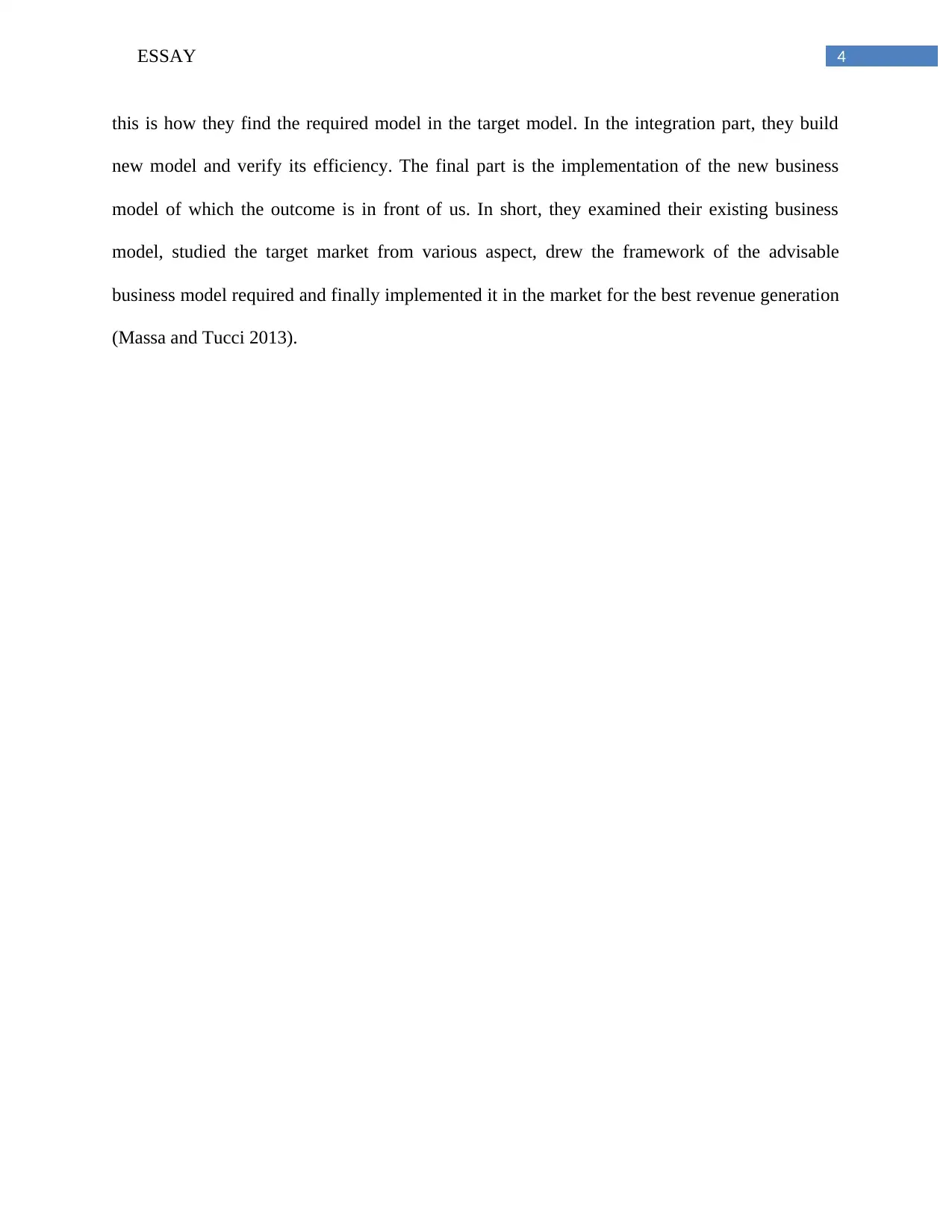
4ESSAY
this is how they find the required model in the target model. In the integration part, they build
new model and verify its efficiency. The final part is the implementation of the new business
model of which the outcome is in front of us. In short, they examined their existing business
model, studied the target market from various aspect, drew the framework of the advisable
business model required and finally implemented it in the market for the best revenue generation
(Massa and Tucci 2013).
this is how they find the required model in the target model. In the integration part, they build
new model and verify its efficiency. The final part is the implementation of the new business
model of which the outcome is in front of us. In short, they examined their existing business
model, studied the target market from various aspect, drew the framework of the advisable
business model required and finally implemented it in the market for the best revenue generation
(Massa and Tucci 2013).
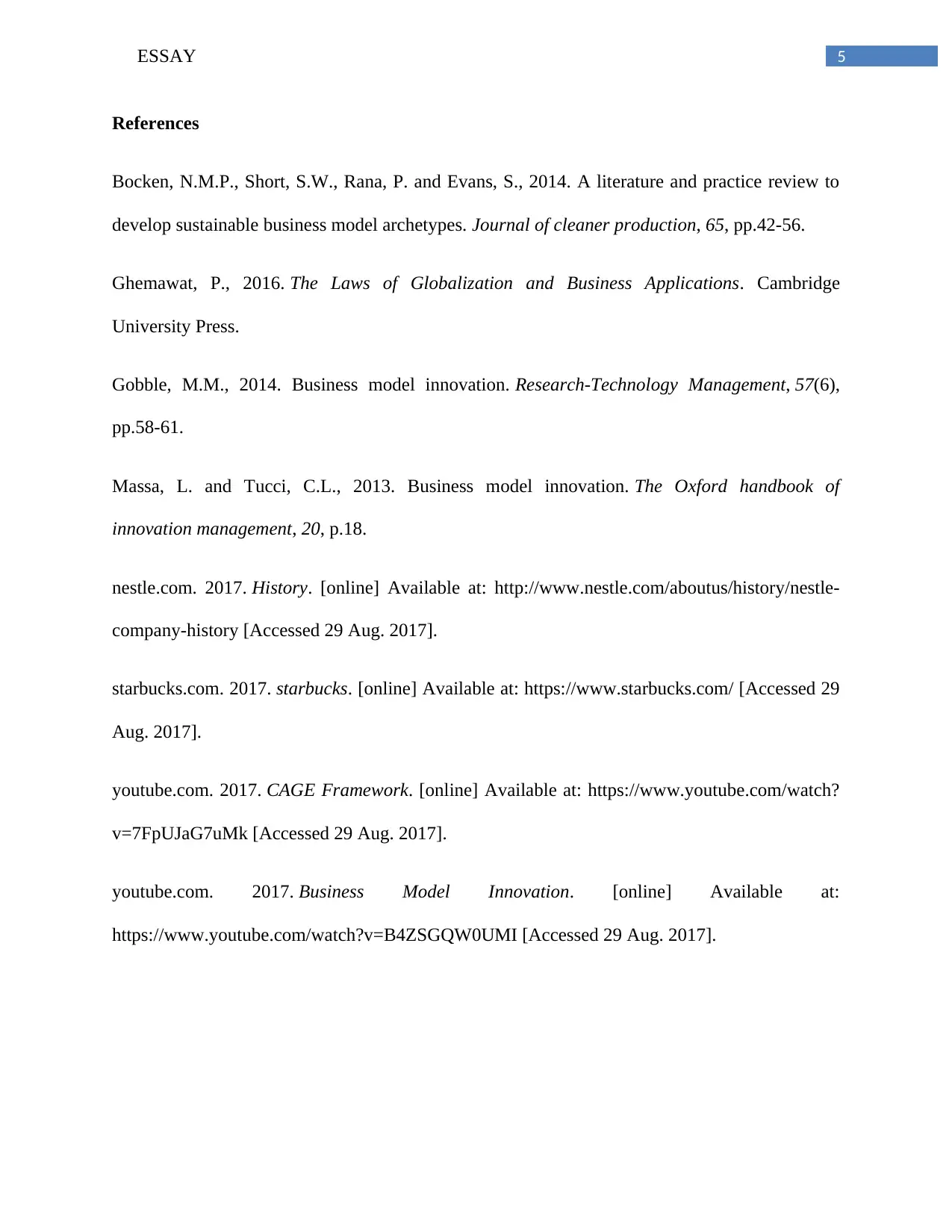
5ESSAY
References
Bocken, N.M.P., Short, S.W., Rana, P. and Evans, S., 2014. A literature and practice review to
develop sustainable business model archetypes. Journal of cleaner production, 65, pp.42-56.
Ghemawat, P., 2016. The Laws of Globalization and Business Applications. Cambridge
University Press.
Gobble, M.M., 2014. Business model innovation. Research-Technology Management, 57(6),
pp.58-61.
Massa, L. and Tucci, C.L., 2013. Business model innovation. The Oxford handbook of
innovation management, 20, p.18.
nestle.com. 2017. History. [online] Available at: http://www.nestle.com/aboutus/history/nestle-
company-history [Accessed 29 Aug. 2017].
starbucks.com. 2017. starbucks. [online] Available at: https://www.starbucks.com/ [Accessed 29
Aug. 2017].
youtube.com. 2017. CAGE Framework. [online] Available at: https://www.youtube.com/watch?
v=7FpUJaG7uMk [Accessed 29 Aug. 2017].
youtube.com. 2017. Business Model Innovation. [online] Available at:
https://www.youtube.com/watch?v=B4ZSGQW0UMI [Accessed 29 Aug. 2017].
References
Bocken, N.M.P., Short, S.W., Rana, P. and Evans, S., 2014. A literature and practice review to
develop sustainable business model archetypes. Journal of cleaner production, 65, pp.42-56.
Ghemawat, P., 2016. The Laws of Globalization and Business Applications. Cambridge
University Press.
Gobble, M.M., 2014. Business model innovation. Research-Technology Management, 57(6),
pp.58-61.
Massa, L. and Tucci, C.L., 2013. Business model innovation. The Oxford handbook of
innovation management, 20, p.18.
nestle.com. 2017. History. [online] Available at: http://www.nestle.com/aboutus/history/nestle-
company-history [Accessed 29 Aug. 2017].
starbucks.com. 2017. starbucks. [online] Available at: https://www.starbucks.com/ [Accessed 29
Aug. 2017].
youtube.com. 2017. CAGE Framework. [online] Available at: https://www.youtube.com/watch?
v=7FpUJaG7uMk [Accessed 29 Aug. 2017].
youtube.com. 2017. Business Model Innovation. [online] Available at:
https://www.youtube.com/watch?v=B4ZSGQW0UMI [Accessed 29 Aug. 2017].
⊘ This is a preview!⊘
Do you want full access?
Subscribe today to unlock all pages.

Trusted by 1+ million students worldwide
1 out of 6
Related Documents
Your All-in-One AI-Powered Toolkit for Academic Success.
+13062052269
info@desklib.com
Available 24*7 on WhatsApp / Email
![[object Object]](/_next/static/media/star-bottom.7253800d.svg)
Unlock your academic potential
Copyright © 2020–2025 A2Z Services. All Rights Reserved. Developed and managed by ZUCOL.





